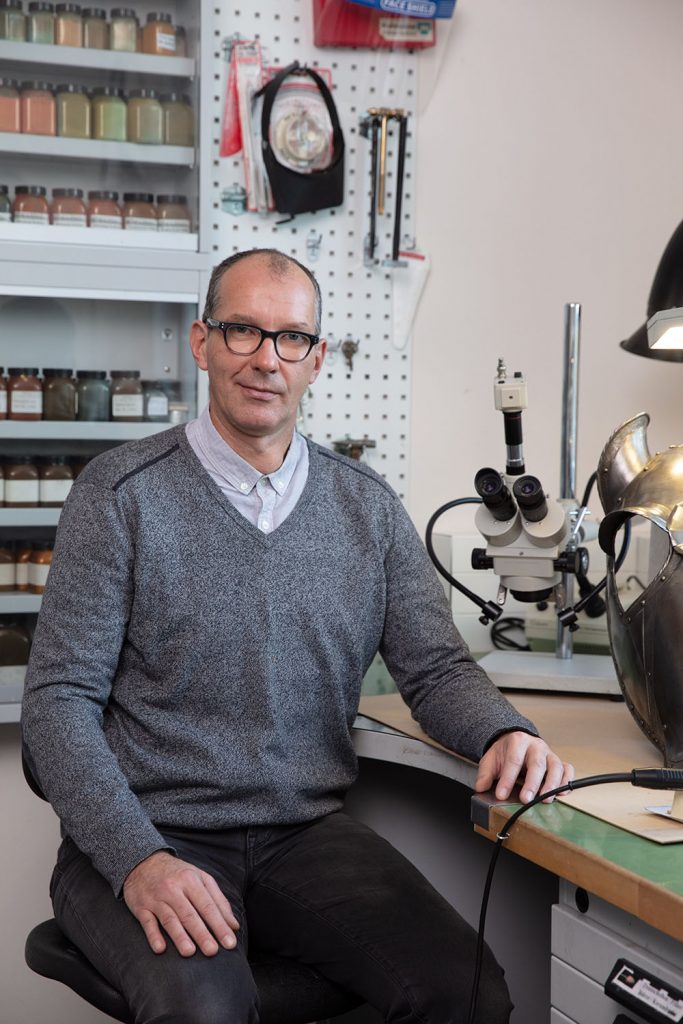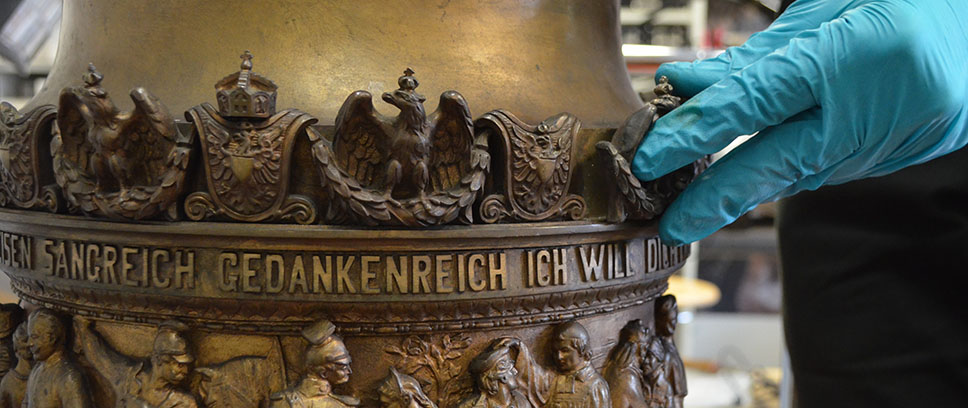
Restoration of the Replica of a Commemorative Column
Dr. Sabine Beneke, Kay Draber und David Pfeffer | 12 October 2022
For the exhibition “Citizenships. France, Poland, Germany since 1789”, the replica of a commemorative column was extensively restored. Kay Draber, metal restorer, Dr. Sabine Beneke, head of the collection, and David Pfeffer, project assistant of the exhibition, recount the steps that had to be undertaken to restore the column, what had to be kept in mind, and why this object is relevant to the exhibition.
To begin with, the Deutsches Historisches Museum’s bronze commemorative column of the “Association of War Volunteers of 1870/71” stands out visually compared with a great many of the other objects in the exhibition. Alongside the so-called “flatware” (two-dimensional paper objects), the exponent functions as a provocative eyecatcher in the middle of the first room.
The restorative process
Kay Draber
Since the exhibition designers planned from the start to show the object from all sides but a component of the column was missing, it needed to be restored. Originally, there were ten metallic eagle appliqués and ten muscle cuirasses mounted alternately on the upper frieze. Above the inscription on the front side, one of the eagle appliqués had been lost. It is no longer known how or why this came about.
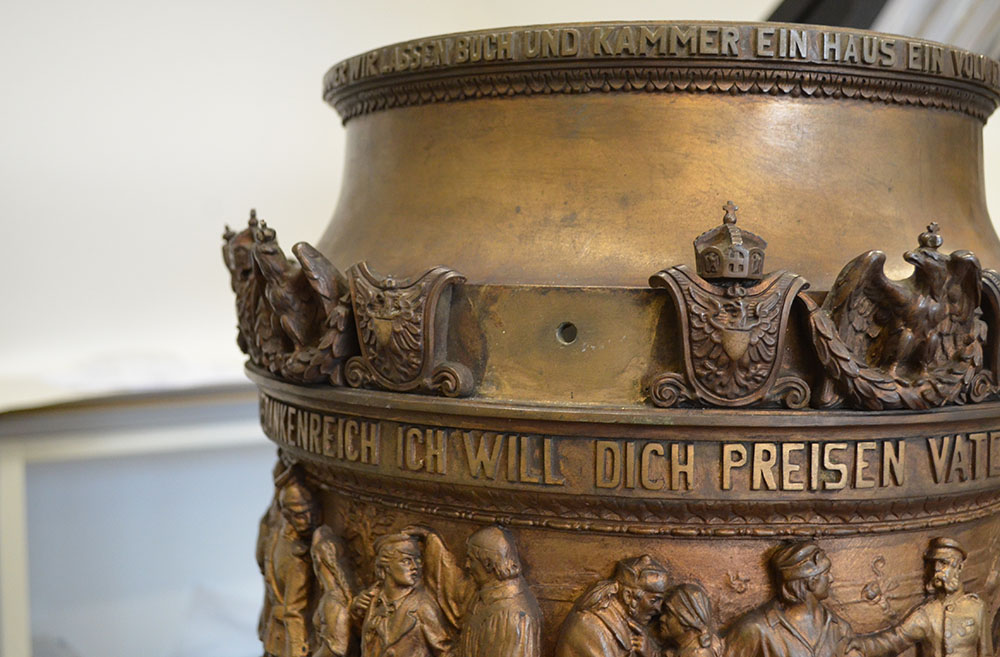
Since the eagle appliqué was lacking at a central position on the column, it had to be recast and added to the frieze. In keeping with the original material and manufacturing technique, the restorers of the Deutsches Historisches Museum decided to make a copy of the original bronze cast. For this purpose, one of the nine extant eagle appliqués had to be dismounted and brought to a company specialising in bronze and art sculpture casting (Thomas Seiler GmbH in Schöneiche). There, a silicon cast was made and then recast in bronze and enchased.
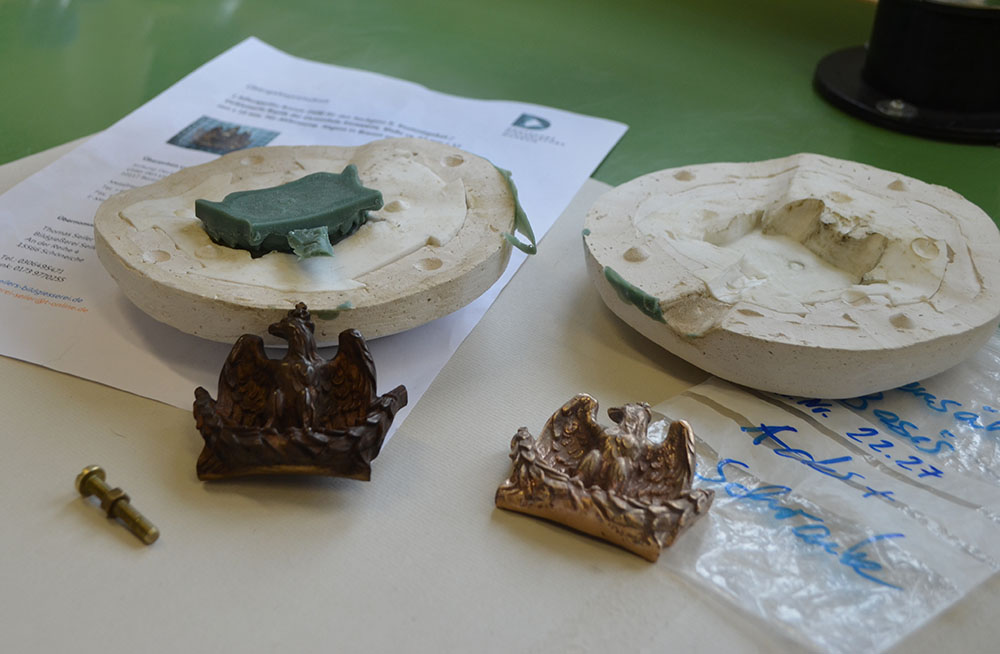
After that, the necessary thread hole for the screw mounting onto the object was bored and the chemical patination to match the colour of the original bronze was prepared in the DHM’s restoration workshop. “DHM” and “2022” were imprinted on the back side of the recast appliqué so that eagle would be indicated for all time as a restorative measure.
The history of the replica
Dr. Sabine Beneke
The commemorative column of the “Association of the War Volunteers of 1870/71” was a smaller version of a 12.60 m high monument from 1870 that was mounted on a pedestal. The monument marked the end of a festively decorated “Via Triumphalis” (Victory Street”) through Berlin. After the Franco-Prussian War, the victorious Prussian troops marched with Kaiser Wilhelm I on 16 June 1871 from the Kreuzberg monument along the boulevard “Unter den Linden” to the palace. There it stood: a large commemorative column made provisionally of plaster, because it was created specially for this occasion. Enthroned on top of it was the personification of Germania in a coronation mantle, accompanied by her reconquered “daughters,” Alsace and Lorraine. The column was surrounded by a relief designed by the sculptor Rudolf Siemering (1835–1905), illustrating “Germany’s military strength”. 35 figures followed the trumpet call of a herald. They represented the call to arms of the German people. Persons from all the German states and all classes populated the relief; farewell scenes with conscripted soldiers showed veterans of the Wars of Independence of 1813–1815 who stayed behind. Many people still visited the monument weeks after the event. Plans to reproduce the statue in weather-resistant material, to be financed by donations, could not be realised, however.
Thirty years later, after the commemorative column replica had been produced, the war volunteers added a base to it “so that the column as a whole would not appear compressed despite its reduced size. This also made it possible to take account of our need to honour the three figures in whose personalities that great period with its world-shaking achievements was reflected: Kaiser Wilhelm the Great, Bismarck and Moltke,” reported the Association’s Festschrift in 1920. Medallions with portraits of the three were added. Kaiser Wilhelm II donated a bronze cannon that had been captured in the Franco-Prussian War for the manufacture of the column.

The column served as table decoration at the annual meeting of the Association on the anniversary of Wilhelm I’s birthday, 22 March. After the death of the last war volunteer, the column was transferred to the Zeughaus in 1922, now the seat of the Deutsches Historisches Museum, where it was placed next to the commemorative column of the Voluntary Riflemen of 1813 to 1815 (Inv. Nr. AB 2975). The columns – as the Festschrift stated – “shall tell future generations how Germany’s youth was always ready to volunteer for the fight to assure the wellbeing and protection of the fatherland.”
In the course of the Second World War, Germania together with the “daughters,” Alsace and Lorraine, were lost.
The meaning for the exhibition
David Pfeffer
A central element of the exhibition “Citizenships. France, Poland, Germany since 1789” is the eventful and conflict-ridden history of different border regions of the individual countries. After its devastating defeat in the Franco-Prussian War of 1870/71, France had to concede its border regions Alsace and Lorraine to the German Empire. In its original form, the commemorative column illustrated this decisive caesura. As a replica of the victory monument of 1871, Germania graced the column as an allegory of the German national state. She spread her motherly arms over Alsatia and Lotharingia, the personifications of the newly annexed “Reichland” Alsace-Lorraine. This reinforced the German Empire’s claim to power over the Franco-German border regions. For the French citizens who lived in Alsace and Lorraine at the time, the annexation had far-ranging consequences. They had to make a profound decision. Should they change their citizenship and thus become German subjects? Or should they remain loyal to the French nation, which meant that they would have to leave their homeland?
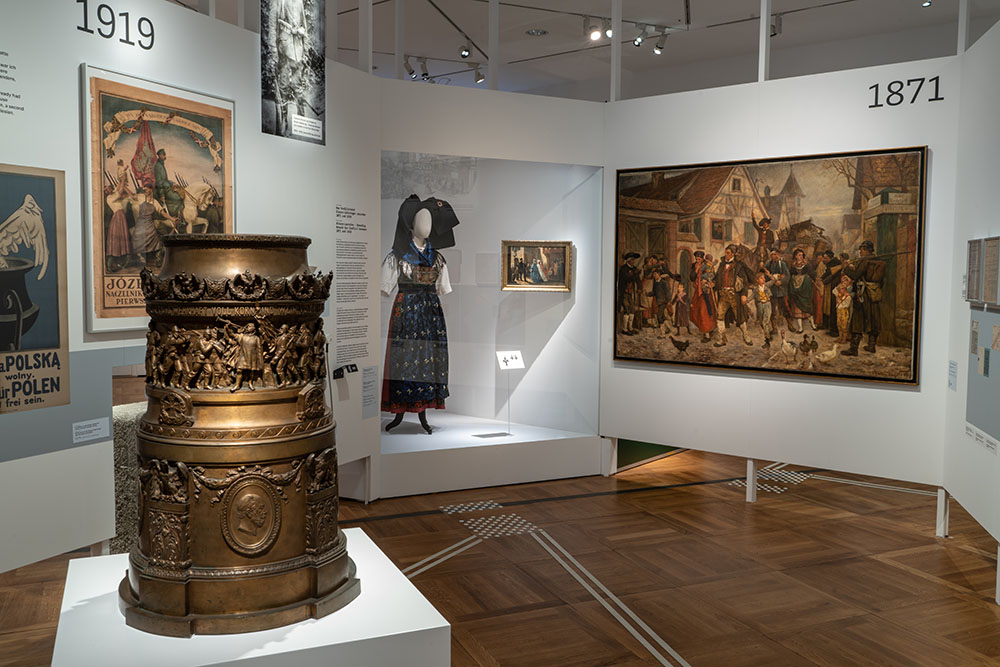
The commemorative column does not illustrate the loyalty to the homeland or its possible loss. It is exclusively a means of representing domination and illustrating the military preparedness of the newly founded German nation. In this way, the object forms a contrast to the painting “A Patriotic Incident in Strasbourg” from 1873 and the “Liberation Dress” from 1918, which are located in the immediate vicinity of the commemorative column. These objects show the creative way in which the population dealt with the new power relations. By wearing the French national colours blue, white and red, it was possible to give expression to patriotic feelings.
The restored commemorative column can be seen in the exhibition on the ground floor of the Pei Building until 15 January 2023.
Dr. Sabine BenekeDr. Sabine Beneke is the head of the collection “Arts: Paintings – Sculptures” at the Deutsches Historisches Museum. |
David PfefferDavid Pfeffer is the project assistant for the exhibition “Citizenships. France, Poland, Germany since 1789” at the Deutsches Historisches Museum. |
|
|
Kay DraberKay Draber worked as metal restorer at the Deutsches Historisches Museum. Since October 2022 he is working as chief restorer at the Grassi Museum in Leipzig. |
